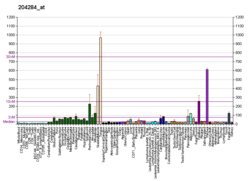PPP1R3C
Protein phosphatase 1 regulatory subunit 3C also known as PTG is an enzyme that in humans is encoded by the PPP1R3C gene.[5][6]
Function
Protein phosphatase-1 (PP1) participates in the regulation of a wide variety of cellular functions by reversible protein phosphorylation. The ability of PP1 to regulate diverse functions resides in its capacity to interact with a variety of regulatory subunits that may target PP1 to specific subcellular locations, modulate its substrate specificity, and allow its activity to be responsive to extracellular signals. Several targeting subunits of PP1 have been identified, including PPP1R5, the glycogen-binding subunits GM, GL, PTG and R6 and PPP1R4, and the nuclear inhibitor of PP1 (PPP1R8).[6]
References
- 1 2 3 GRCh38: Ensembl release 89: ENSG00000119938 - Ensembl, May 2017
- 1 2 3 GRCm38: Ensembl release 89: ENSMUSG00000067279 - Ensembl, May 2017
- ↑ "Human PubMed Reference:".
- ↑ "Mouse PubMed Reference:".
- ↑ Doherty MJ, Young PR, Cohen PT (Jan 1997). "Amino acid sequence of a novel protein phosphatase 1 binding protein (R5) which is related to the liver- and muscle-specific glycogen binding subunits of protein phosphatase 1". FEBS Lett. 399 (3): 339–43. doi:10.1016/S0014-5793(96)01357-9. PMID 8985175.
- 1 2 "Entrez Gene: PPP1R3C protein phosphatase 1, regulatory (inhibitor) subunit 3C".
Further reading
- Armstrong CG, Browne GJ, Cohen P, Cohen PT (1998). "PPP1R6, a novel member of the family of glycogen-targeting subunits of protein phosphatase 1". FEBS Lett. 418 (1–2): 210–4. doi:10.1016/S0014-5793(97)01385-9. PMID 9414128.
- Permana PA, Luczy-Bachman G, Bogardus C (1999). "Protein targeting to glycogen/PPP1R5: screening of coding and flanking genomic regions for polymorphisms and association analysis with insulin action in Pima Indians". Biochem. Biophys. Res. Commun. 258 (1): 184–6. doi:10.1006/bbrc.1999.0614. PMID 10222257.
- Hartley JL, Temple GF, Brasch MA (2001). "DNA Cloning Using In Vitro Site-Specific Recombination". Genome Res. 10 (11): 1788–95. doi:10.1101/gr.143000. PMC 310948. PMID 11076863.
- Wiemann S, Weil B, Wellenreuther R, et al. (2001). "Toward a Catalog of Human Genes and Proteins: Sequencing and Analysis of 500 Novel Complete Protein Coding Human cDNAs". Genome Res. 11 (3): 422–35. doi:10.1101/gr.GR1547R. PMC 311072. PMID 11230166.
- Simpson JC, Wellenreuther R, Poustka A, et al. (2001). "Systematic subcellular localization of novel proteins identified by large-scale cDNA sequencing". EMBO Rep. 1 (3): 287–92. doi:10.1093/embo-reports/kvd058. PMC 1083732. PMID 11256614.
- Strausberg RL, Feingold EA, Grouse LH, et al. (2003). "Generation and initial analysis of more than 15,000 full-length human and mouse cDNA sequences". Proc. Natl. Acad. Sci. U.S.A. 99 (26): 16899–903. doi:10.1073/pnas.242603899. PMC 139241. PMID 12477932.
- Wiemann S, Arlt D, Huber W, et al. (2004). "From ORFeome to Biology: A Functional Genomics Pipeline". Genome Res. 14 (10B): 2136–44. doi:10.1101/gr.2576704. PMC 528930. PMID 15489336.
- Mehrle A, Rosenfelder H, Schupp I, et al. (2006). "The LIFEdb database in 2006". Nucleic Acids Res. 34 (Database issue): D415–8. doi:10.1093/nar/gkj139. PMC 1347501. PMID 16381901.
This article is issued from
Wikipedia.
The text is licensed under Creative Commons - Attribution - Sharealike.
Additional terms may apply for the media files.




